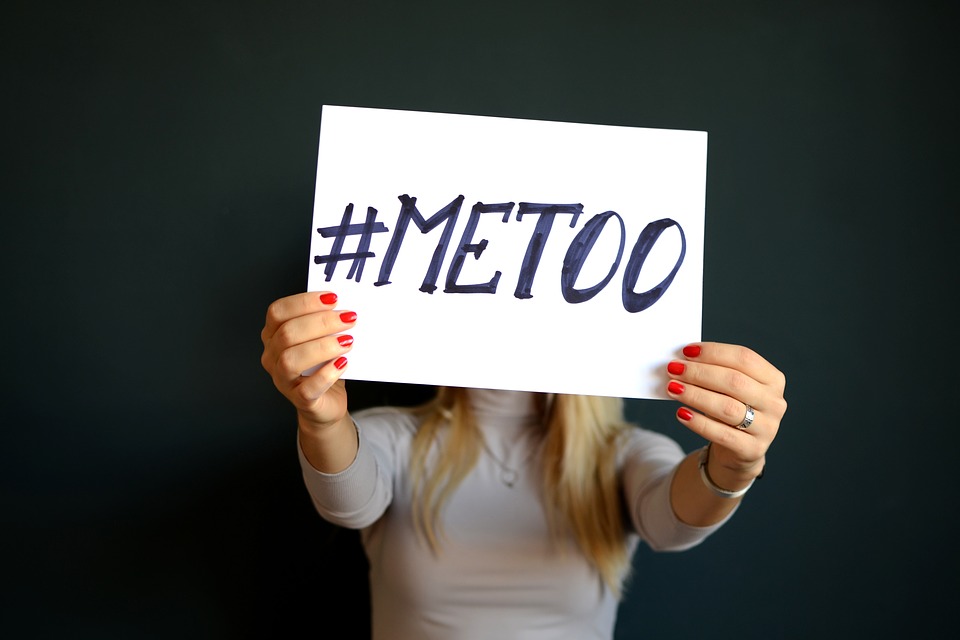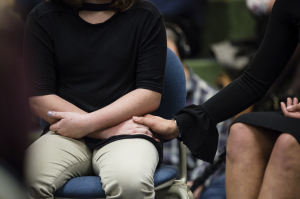By Rasheca Logendran
It is 2018. On the way to class, my friend reviewed her Saturday night. She nonchalantly recounted how a boy – uninvited – thrust his waist up against her and wouldn’t let her go. “Just another college party,” she said. As I entered the classroom, I checked Twitter and found a flood of #MeToo hashtags. As I sat at my desk, I overhead classmates discuss how 40 percent of women had experienced assault on campus.
Just another day in America. A place where we breathe in sexual assault as a natural part of our atmosphere so as to prevent being smothered by its horrors. As we ignore the growing pollutant, it slowly collects in the atmosphere – 40 percent turns to 50 percent, and 50 percent then turns to 60 percent. The clouds darken, the storms sets in, and we ignore the toxic downpour. By 2050, sexual assault will no longer be a travesty, it will be a sinister rite of passage.
But what if we stopped and questioned where this pollutant came from? What if we could work to prevent the storm from setting? What if we questioned the roots of sexual assault and began attacking its root cause? What if today, in 2018, we asked how exactly did sexual assault transform from a novelty to our current reality?
I believe it is because we all – man, woman, child, perpetrator – have forgotten what it means to be human. We have forgotten that we are much more than just an isolated sack of skin and organs, but are all a complicated mishmash of mind and soul existing in a world with others.
We don’t have a sexual assault problem – we have an underlying societal problem. If we don’t fix how our society functions today, it will only continue to deteriorate and perpetuate the toxic norms of today and amplify and continue into 2050.
We forget that underneath our powerful steel machines, there is a fragile driver whose actions affect everyone on the highway. We forget that with sexual misconduct, we are never just talking about simple scratches, but rather a collision that deploys airbags, shatters windshields, and ejects the battered driver from the front seat.
While we typically grant unyielding respect and concern to our mothers and sisters, we fail to extend these considerations to those we don’t intimately know. Our problems are the ingrained power dynamics and gender norms that allow us to turn a blind eye to universal human complexity. We forget that a part of being human means recognizing that humanity in everyone.
When we don’t understand what it means to be human, limit those who we grant humanity to, live our lives as though our actions are isolated, and focus on simply the peripheral damage, we create an atmosphere fertile for the germination of sexual misconduct.
With sexual assault, we forget that our actions cause profound trauma, which not only engulfs its victims in its fire but also leaves them so permanently disfigured that they are unable to recognize themselves past the embers.
With sexual assault, we forget that our actions affect everyone. When we deny our collective role in shaping this culture, we isolate and blame victims – making them feel as though they got burned for simply standing too close to the flames.
With sexual assault, we focus only on the peripheral damage, using clinical measures, collecting swabs and scratches as evidence. We consider assault to be simple incidents, allowing victims to be choked into silence by the lingering smoke and the chronic smell of charred flesh.
Although clarifying consent, creating campaigns, and providing resources for victims are integral in combating assault, if we want to try to fix our sexual assault problem, we need to go back to its cause.
If we want people to responsibly navigate through society and treat one another with respect, we need much more than simple road signs and laws – we need to teach the drivers how to drive.
How? By revolutionizing sexual health education. We need more than sermons on abstinence or conversations about contraceptives. We must expand the purviews of sex-ed to include the social dynamics of sexuality.
By deconstructing the gender norms of women as submissive and men as powerful we can show students what healthy relationship looks like – one in which boundaries are communicated and respected. We can teach students that you always ask for permission before touching another. We can prevent another friend from being cornered at a party.
By analyzing the role of power dynamics in sexuality, we can work to combat the normalization of assault. We can equip students with the knowledge of how to recognize assault. We can remind them that they are not expected (and should not expect others) to comply with unwanted sexual advances.
By discussing our roles in perpetuating these destructive social pressures, we can remind students that we are all responsible for combating sexual assault. We can remind students that it is never the victim’s fault, and we all have a responsibility to intervene if we see someone being preyed upon at a party.
If we don’t change our policies today, we will be sending a message to future generations that sexual assault doesn’t matter. In 2050, we still won’t have a solution to the issues we face today regarding sexual assault. Instead, they will be worse.
We need to equip our students with the tools to combat the societal pressures that create our sexual assault problem. We need to revolutionize sexual health education.
- Baker, Katie J.M. “Here’s The Powerful Letter The Stanford Victim Read To Her Attacker.” BuzzFeed. www.buzzfeed.com/katiejmbaker/heres-the-powerful-letter-the-stanford-victim-read-to-her-ra?utm_term=.ul8qDnEon#.qm048V3JV.
- Gabler, Ellen, et al. “NBC Fires Matt Lauer, the Face of ‘Today.’” The New York Times, 29 Nov. 2017. www.nytimes.com/2017/11/29/business/media/nbc-matt-lauer.html
- “Harvey Weinstein Timeline: How the Scandal Unfolded.” BBC News, 12 Feb. 2018. www.bbc.com/news/entertainment-arts-41594672.
- Fox, Kara. “University Survey Reveals ‘Startling’ Sexual Misconduct Statistics.” The Chronicle, 8 Mar. 2017, www.dukechronicle.com/article/2017/03/student-affairs-survey-reveals-startling-sexual-misconduct-statistics.
- Langone, Alix. “What Is the Time’s Up Movement and the #MeToo Movement?” Time, Time, 8 Mar. 2018, time.com/5189945/whats-the-difference-between-the-metoo-and-times-up-movements/.
- Canan, S.N. & Jozkowski, K.N. “Sexual Health Education Topics in Schools: Inclusion and Timing Preferences of a Sample of Southern U.S. College Students” Sexuality Resource and Social Policy (2017) 14: 143. https://doi-org.proxy.lib.duke.edu/10.1007/s13178-016-0251-z
- Day, K. (1994). Conceptualizing women’s fear of sexual assault on campus: A review of causes and recommendations for change. Environment and Behavior, 26(6), 742. Retrieved from https://login.proxy.lib.duke.edu/login?url=https://search-proquest-com.proxy.lib.duke.edu/docview/1292650002?accountid=10598
- Hall, Kelli Stidham et al. “The State of Sex Education in the United States.” The Journal of adolescent health : official publication of the Society for Adolescent Medicine 58.6 (2016): 595–597. PMC. Web. 8 Apr. 2018.
- Munro, V. E. (2017). Shifting Sands? Consent, Context
and Vulnerability in Contemporary Sexual Offences Policy in England and Wales. Social & Legal Studies, 26(4), 417-440.doi :10.1177/0964663916682584 - National Sexual Violence Resource Center. It’s Time to Talk About Gender
Norms , 2012. - Ruiz, Rebecca. “Want to Prevent Sexual Violence? Teach Kids Everything They Need to Know about Sex.” Mashable, Mashable, 25 Oct. 2017, mashable.com/2017/10/25/teach-sex-ed-prevent-sexual-harassment-and-assault/#4t_S5WVKcPqG.
- Salam, Maya. “Brock Turner Is Appealing His Sexual Assault Conviction.” The New York Times, The New York Times, 3 Dec. 2017, www.nytimes.com/2017/12/02/us/brock-turner-appeal.html.
- Spakovsky, Hans von. “Campus Sexual Assault: Understanding the Problem and How to Fix It.” The Heritage Foundation, The Heritage Foundation, 25 July 2017, www.heritage.org/crime-and-justice/report/campus-sexual-assault-understanding-the-problem-and-how-fix-it.
- Wallace, Kelly. “Study: 23% of Women Sexually Assaulted in College.” CNN, Cable News Network, 23 Sept. 2015, www.cnn.com/2015/09/22/health/campus-sexual-assault-new-large-survey/index.html.
- “What Is Sexual Violence?” Causes, Statistics & Sex Assault
Types , Minnesota Coalition Against SexualAssault , www.mncasa.org/what-is-sexual-violence/. - “What Is Sexual Consent? | Facts About Rape & Sexual Assault.” Planned Parenthood, Planned Parenthood Federation of America, www.plannedparenthood.org/learn/sex-and-relationships/sexual-consent








Be First to Comment